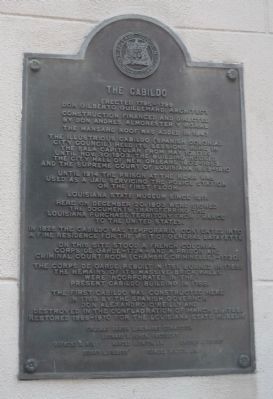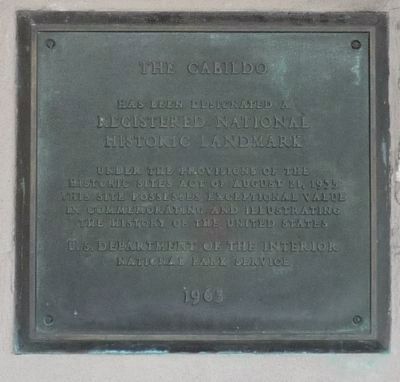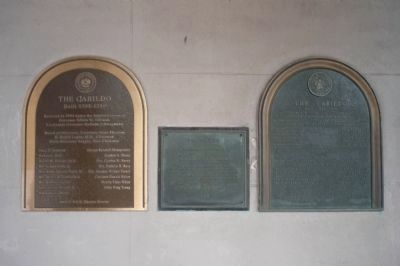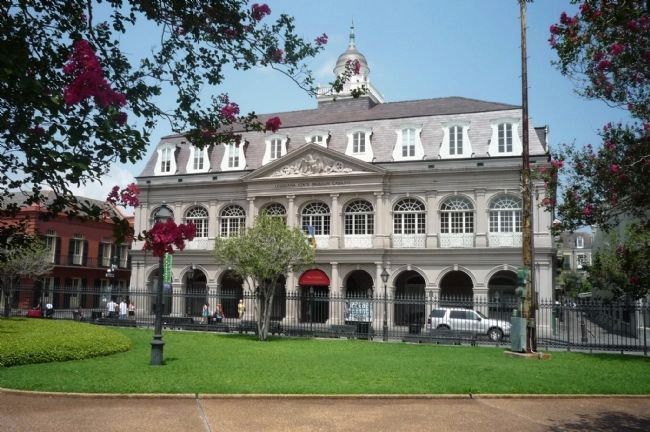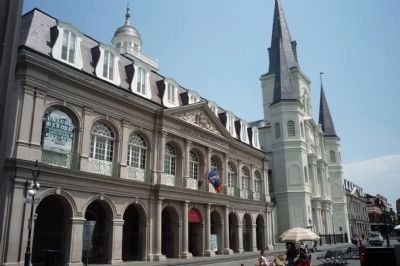French Quarter in New Orleans in Orleans Parish, Louisiana — The American South (West South Central)
The Cabildo
National Historic Landmark
— Louisiana State Museum —
[Panel 1:]
Erected 1795-1799,
Don Gilberto Guillemard, architect.
Constructed financed and directed by Don Andres Almonester y Roxas.
The mansard roof was added in 1847.
The illustrious Cabildo (Spanish colonial city council) held its sessions here in the Sala Capitular from May 10, 1799 until Nov. 30, 1803. The building housed the city hall of New Orleans, 1803-1853, and the supreme court of Louisiana, 1853-1910.
Until 1914, the prison at the rear was used as a jail servicing the police station on the first floor.
Louisiana State Museum since 1911.
Here on December 20, 1803, were signed the documents transferring the Louisiana Purchase Territory from France to the United States. In 1825 the Cabildo was converted into a fine residence for the visiting General Lafayette.
On this site stood a French colonial Corps de Garde [police station] - 1724 - and a prison and criminal court room (chambre criminelle) - 1730.
The Corps de Garde, rebuilt in 1751, burned in 1788. The remains of its massive brick walls were incorporated in the present Cabildo building in 1795.
The first Cabildo building was constructed here in 1769 by the Spanish governor, Don Alexandro O’Reilly and destroyed in the conflagration of March 21, 1788. Restored 1966-1970 for the Louisiana State Museum.
Orleans Parish Landmark Commission: Leonard V. Huber, President; Raymond A. Mix; Harold J. Smith. Jr.; Gasper J. Schird; Sidney L. Villeré; Samuel Wilson, Jr.
Logo of the Orleans Parish Landmarks Commission
[Panel 2:]
The Cabildo has been designated a Registered National Historic Landmark.
Under the provisions of the Historic Sites Act of August 21, 1935, this site possesses exceptional value in commemorating and illustration the history of the United States.
U.S. Department of the Interior, National Park Service.
Erected 1963 by the Orleans Parish Landmarks Commission and the National Park Service.
Topics and series. This historical marker is listed in these topic lists: African Americans • Colonial Era • Settlements & Settlers. In addition, it is included in the Lafayette’s Farewell Tour, and the National Historic Landmarks series lists. A significant historical date for this entry is March 21, 1794.
Location. 29° 57.452′ N, 90° 3.83′ W. Marker is in New Orleans, Louisiana, in Orleans Parish. It is in the French Quarter. Marker can be reached from the intersection of Chartres Street and St. Peter Street, on the left when traveling east. The marker panels are on the wall near the building's main (Louisiana State Museum) entrance, off the Chartres Street sidewalk, across from Jackson Square. Touch for map. Marker is at or near this postal address: 701 Chartres Street, New Orleans LA 70116, United States of America. Touch for directions.
Other nearby markers. At least 8 other markers are within walking distance of this marker. Napoleon 12-pounder cannon (here, next to this marker); To the French Patriots of 1768 (here, next to this marker); Don Bernardo de Galvez (here, next to this marker); Spanish cannon (here, next to this marker); a different marker also named The Cabildo (a few steps from this marker); a different marker also named The Cabildo (a few steps from this marker); Upper Pontabla Building (a few steps from this marker); David Bannister Morgan (within shouting distance of this marker). Touch for a list and map of all markers in New Orleans.
Related marker. Click here for another marker that is related to this marker. The Homer Adolph Plessy Marker
Also see . . . Louisiana State Museum. The Louisiana State Museum also occupies the Presbytère, the Cabildo's twin edifice on the opposite side of the St. Louis Cathedral, and manages other Landmark buildings adjacent to Jackson Square. (Submitted on August 10, 2009, by Richard E. Miller of Oxon Hill, Maryland.)
Additional keywords. Franco-Americans; Creoles; Homer A. Plessy; Presbytère.
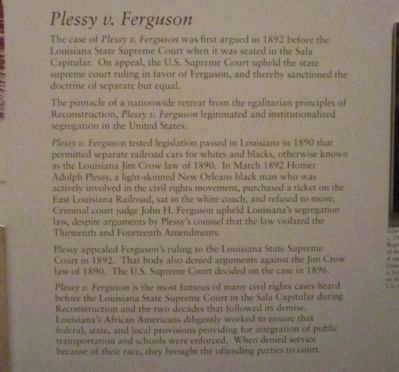
Photographed By Richard E. Miller, July 14, 2009
5. Plessy vs. Ferguson - interior Louisiana State Museum panel
describing the Louisiana Supreme Court's landmark decision (rendered in the Cabildo building in 1892 and subsequently upheld by the U.S. Supreme Court) sanctioning the state's laws requiring racial segregation in public facilities under the doctrine of "separate but equal" - a hypocritical policy of discrimination that remained in effect in many states until the mid-20th century.
Credits. This page was last revised on February 12, 2023. It was originally submitted on August 10, 2009, by Richard E. Miller of Oxon Hill, Maryland. This page has been viewed 2,510 times since then and 53 times this year. Photos: 1, 2, 3, 4, 5. submitted on August 10, 2009, by Richard E. Miller of Oxon Hill, Maryland. 6. submitted on August 11, 2009, by Richard E. Miller of Oxon Hill, Maryland. • Kevin W. was the editor who published this page.
